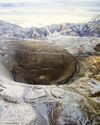
BBC Sky at Night Magazine
Battle of the Big Bang
About 13.8 billion years ago, the Universe burst forth from an infinitely dense inferno, started to expand and cool, and is still expanding to this day. The Big Bang is “science's earliest memory”, as authors Niayesh Afshordi and Phil Halper point out in this new book, so it's natural to ask what happened before it. But you may have been told that this is a daft question, because if time began at the Big Bang, then there can be no ‘before’. Battle of the Big Bang is here to debunk this myth and guide the reader between public perception and what cosmologists believe today.
1 min |
July 2025

BBC Sky at Night Magazine
O&A WITH A FILAMENT FINDER
Researchers looking at the centre of our Galaxy have discovered a first: long, slim filaments made not of dust but gas, and forged by powerful shockwaves
2 min |
July 2025

BBC Sky at Night Magazine
One of largest space structures to date discovered
The giant ball of hydrogen, named Eos, has been found on Earth's doorstep
1 min |
July 2025

BBC Sky at Night Magazine
Diffraction spikes
Stars don't actually have spikes, but that's how we see them thanks to bending light
3 min |
July 2025

BBC Sky at Night Magazine
JWST finds frozen water in a young star system
Long-awaited discovery finds crystalline water-ice in star's debris disc
1 min |
July 2025

BBC Sky at Night Magazine
Mystery of Jupiter's luminous aurorae solved
High-energy particles trigger ultra-bright dancing lights in Jupiter's atmosphere
1 min |
July 2025

BBC Sky at Night Magazine
Signs point to Planet 9
We may have found the first direct evidence of a ninth major planet in the Solar System
2 min |
July 2025

BBC Sky at Night Magazine
Make a stunning skyscape
Combine the night sky and landscape to brilliant effect
3 min |
July 2025
BBC Sky at Night Magazine
the Tracking stars
Ancient skywatchers of the Four Corners
7 min |
July 2025

BBC Sky at Night Magazine
Who really invented the telescope?
No, it wasn't Galileo. Govert Schilling untangles the tale of astronomy's greatest creation, and recounts what happened next
7 min |
July 2025

BBC Sky at Night Magazine
Sky-Watcher Heliostar 76Ha telescope
Holding out for a first-rate solar scope at an affordable price? The wait may be over
3 min |
July 2025

BBC Sky at Night Magazine
How to photograph NLCs for science
Noctilucent clouds are fleeting and mysterious - if you catch them, your data can be useful
3 min |
July 2025

The Week Junior Science+Nature UK
Could you dig all the way through the planet?
Learn the science behind digging a giant hole.
3 min |
June 2025

The Week Junior Science+Nature UK
Controlling the weather
Is technology being used to change the weather, or is it science fiction?
3 min |
June 2025

The Week Junior Science+Nature UK
Fabien Cousteau
Meet the ocean explorer who plans to build a futuristic base under the sea.
3 min |
June 2025

The Week Junior Science+Nature UK
NEXT STOP: THE FUTURE
All aboard as JD Savage takes the fast track through 200 years of train travel.
5 min |
June 2025

The Week Junior Science+Nature UK
Gladiators fought big cats for entertainment
Scientists have found the first physical evidence in Europe that Roman gladiators fought lions.
1 min |
June 2025

The Week Junior Science+Nature UK
Al decodes animal chat
Computers are giving us the power to understand creature communication.
2 min |
June 2025

The Week Junior Science+Nature UK
HEADSCRATCHERS
Hi, I'm Pete, and I love science and the natural world. I work with the Royal Institution (Ri) in London, where you can find exciting, hands-on science events for young people.
3 min |
June 2025

The Week Junior Science+Nature UK
The race is on between robots and humans
Twenty-one robots competed against human runners in the Yizhuang half-marathon in Beijing, China in April.
1 min |
June 2025

The Week Junior Science+Nature UK
Life on another planet?
Scientists have found molecules (groups of atoms) that could point to life on another planet.
1 min |
June 2025

The Week Junior Science+Nature UK
Sloth toothache cured by dentists
Dental experts have cured a two-toed sloth's toothache through a procedure called an apicectomy (say ap-ee-sek-toe-mee).
1 min |
June 2025

The Week Junior Science+Nature UK
Growing baby corals
Meet the UK scientists giving breeding corals a helping hand.
1 min |
June 2025

The Week Junior Science+Nature UK
First UK baby born from transplanted womb
For the first time in the UK, a baby has been born from a transplanted uterus. When part of a person's body is not working properly, it can sometimes be replaced with the same part from another person.
1 min |
June 2025

The Week Junior Science+Nature UK
SECRETS OF THE SEAS
Take a deep dive beneath the waves as Melissa Hobson reveals the incredible animals that live in our seas.
5 min |
June 2025

How It Works UK
Elusive colossal squid finally caught on camera
The colossal squid has finally been caught on camera, an entire century after it was first discovered.
1 min |
Issue 203

How It Works UK
GREEK TEMPLE CONSTRUCTION
How ancient architects erected some of the world's most famous places of worship
2 min |
Issue 203

How It Works UK
TOUR GUIDE TO MARS
Pack your spacesuit and get ready to tick off the must-see sights of the Red Planet
3 min |
Issue 203

How It Works UK
AMAZING SELF SAILING BOATS
From a modern-day Mayflower to flying water taxis, autonomous vessels are taking their crews farther than ever across the world's waterways
2 min |
Issue 203

How It Works UK
BUILDING A SUPERSCRAPER
Stretching into the sky, the Burj Khalifa in Dubai is by far the tallest human-made structure ever built, and its design will enable us to build even higher
2 min |
